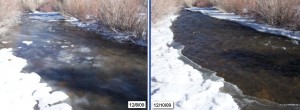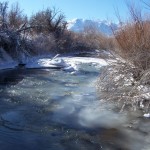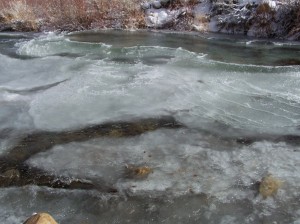
When the temperature drops close to zero, some interesting things happen to the flowing water in Mono Lake’s tributaries. I shot this video on December 8th at Rush Creek right after measuring the flow in a side channel. Ominous cracking noises in the silent below freezing air preceded this dramatic burst of water and ice.


Why are we out there measuring the flow when it is so cold that our instruments–and toes–are freezing up?
The State Water Resources Control Board (SWRCB) granted the Los Angeles Department of Water and Power (LADWP) a temporary change in the minimum flow requirements on Rush and Lee Vining Creek this winter. This is to both retain water in Grant Lake Reservoir, increasing the likelihood of a spill over the dam next spring (needed to achieve high stream restoration flows below the dam), and to study the effect of lower flows on the stream ecosystem. Lower winter flows may be recommended as a restoration measure because the slower water velocities allow trout to conserve energy and possibly grow larger. This winter is a test of these flows. New flow recommendations are due out in 2010.
The SWRCB ordered LADWP to monitor the creeks during this temporary change, among other things to see if ice buildup in Lee Vining Creek is negatively affecting the fishery. The stream scientists in charge of the restoration effort recommended some monitoring that the SWRCB did not order LADWP to conduct, and the Mono Lake Committee is conducting this monitoring: measuring flow in side channels, measuring groundwater levels, as well as recording additional icing observations.
The day this ice dam broke I was out on Rush Creek measuring the flow because LADWP had lowered it for one day to 15 cfs–about half of the flow approved by the SWRCB for the entire winter. The flow was lowered because construction had finished on the Grant Lake Reservoir outlet gate that releases water to Rush Creek, and a low flow was needed to remove bulkheads from the outlet pipe that had kept the construction site dry.
The one-day low flow coincided with the presence of extremely cold arctic air that kept temperatures in Lee Vining below freezing for four days and lowered the air temperature at Rush Creek as low as -11 F. Rush Creek doesn’t typically get as much ice forming on the channel bottom as Lee Vining Creek, but with this unusually-low flow combined with the cold weather, the icing conditions were perfect.
There was evidence of this dynamic activity up and down the creek–it is probably more common than we realize. And it adds to the concern that it is hard to be a fish in the Mono Basin in winter. But in our effort to restore the conditions that benefitted the pre-diversion fishery, we’ll be out there gathering data so that the 2010 flow recommendations will be as well-informed as possible. Even if it means our toes go numb for a few hours. And we’ll be lucky enough to experience fantastic events like this one–and share them with you.

